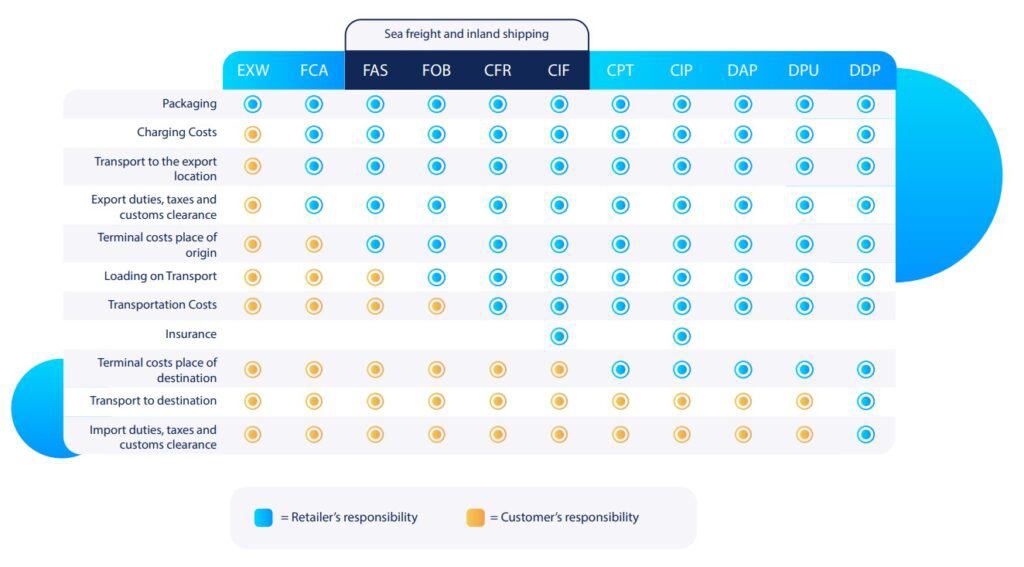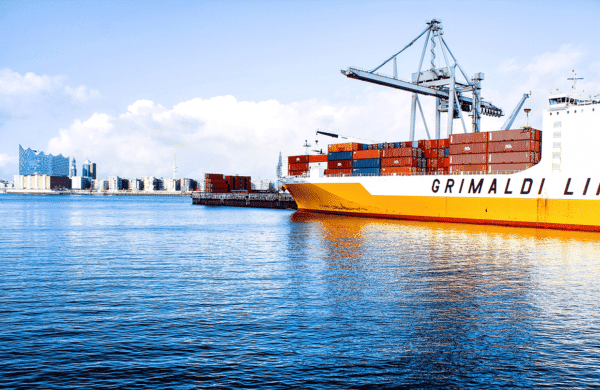The sound of a package being posted through the door is familiar to us all with almost 250 billion parcels sent internationally every year. Whatever your interests, open the internet and you’ll find a global marketplace with international deliveries costing a few dollars (or Euros, or pounds). Buying from abroad is no longer rare, it’s part of the reality of being involved in a global marketplace – and we’re all benefitting.
As customers, we expect international shipping to be fast and stress-free, but behind the scenes it’s not easy. Businesses like yours face increased risks, customs, stricter regulations, and managing returns. If that’s not enough, an estimated one in ten parcels goes missing, so you’ll need a solid returns policy too.
Every business serious about shipping internationally needs a solid strategy in place. There’s no one-size-fits-all, it must be localized, using carriers your customers can trust and backed by rock-solid policies.
If you’re considering shipping internationally, or your business wants to boost global sales, our complete guide to international shipping can help you get things right from day 1.
Table of contents
- What is international shipping? Definition, benefits and challenges
- International markets and their customers
- How to choose the right international carrier
- Calculating shipping costs
- Understanding legal requirements when shipping abroad
- Getting your package through customs
- How to pack and label your international parcels properly
- International shipping insurance
- International returns
- Conclusion

What is international shipping?
International shipping involves sending a parcel outside of your home country. Simple right? Well… not always.
When you send a parcel inside your own country, you’re covered by domestic legislation. When your package crosses country borders, it’s covered by pages and pages of international laws, rules, and regulations. Navigating that is a challenge for anyone (especially those people who don’t love filling in forms).
Shipping outside of a shared economic area is a lot harder, as the delays and disruption caused by Brexit illustrated. Companies that ship to customers in APAC, North America, and South America face a complex array of customs regulations and shipping controls that can be hard to navigate. That’s why finding the right partner and developing a targeted strategy is critical to success.
Benefits of international shipping for online retailers
Expanding your business to include international shipping comes with a host of exciting advantages that can take your online store to new heights. Here are some key benefits to look forward to:
- Expanded customer base: Tap into a global market and reach countless new customers, boosting your sales and revenue.
- Increased brand exposure: Make your brand known and trusted worldwide by selling internationally.
- Competitive advantage: Stand out from competitors by offering international shipping and attract customers looking for global options.
- Higher average order value: International customers often buy more per order to make the shipping cost worthwhile, increasing your average order value.
- Diverse revenue streams: Reduce dependence on a single market by diversifying your customer base across various regions.
- Seasonal demand exploitation: Take advantage of different holiday seasons and shopping peaks around the world to maintain steady sales year-round.
- Learning and growth: Discover new business practices and customer preferences, fostering overall growth and innovation in your company.
Challenges and complications in international shipping
Shipping internationally comes with its own set of unique challenges and complications. Here’s why it’s more complex than domestic shipping:
- Terms, customs and regulations: Each country has its own terms, customs rules and regulations, requiring detailed paperwork and compliance. To help you understand the terms better, we have created an international shipping terms glossary for you!
- Longer transit times: International shipping often involves longer distances and multiple carriers, leading to extended delivery times.
- Higher shipping costs: Shipping across borders can be expensive due to tariffs, duties, and higher shipping rates.
- Risk of delays: Factors like customs inspections, weather, and geopolitical issues can cause unexpected delays.
- Language barriers: Communicating with international customers and partners can be challenging due to language differences.
- Return logistics: Managing international returns is more complex and costly than domestic returns.
- Currency and payment issues: Handling multiple currencies and payment methods adds another layer of complexity.
Despite these challenges, a well-planned strategy, combined with the right expansion technology, can help you navigate the complexities and make the most of international shipping opportunities!
To ensure smooth operations and customer satisfaction, here are the 8 fundamental parts your international shipping strategy should include from our international shipping experts.
How to tackle international shipping challenges?
Don’t want to read the full blog? Check out our video that tackles the top 3 challenges when shipping internationally.
1. International markets and their customers
To successfully navigate international markets, it’s essential to both understand your target customers and comply with country-specific shipping regulations.
Know and understand your target market
Do you really know your customers? That’s the first question every brand that wants to ship internationally should ask.
The E-commerce Delivery Compass report 2023 shows that successful online retailers are building services around customers, dealing with them on their terms.
- The average customer is happy spending hundreds of euros online, ordering an average of 1.8 products per month – that’s over 20 online orders per year.
- Every online retailer knows that (sadly) not every click results in a sale. What’s the main reason customers abandon their orders? 44% say it’s issues with shipping and delivery options that cause them to click out.
- Customers want convenience, but also look to cut costs. 35% say they expect free shipping on orders over €150. However, they’re realistic with 66% understanding that the pandemic has increased shipping costs for all businesses.
- The average customer expects delivery within 3-4 days. They’re willing to wait a maximum of 5 days for delivery – potentially longer than we may have thought.
The study illustrates that customers in different territories have different expectations about shipping times, prices, delivery carriers, and returns policies.
Therefore, creating customer profiles that detail expectations enables you to create an attractive and affordable offer. It also enables you to identify territories where you can meet expectations and those you can’t.
While it’s important to identify differences, digital technologies have seen the emergence of a global consumer class with shared expectations. Across all territories, customers expect a “seamless” customer journey from purchase intent to one-click ordering. Invest in understanding your target market before beginning to build your international shipping strategy.
Read more about how to localize your customer experience here!
Complying with country-specific shipping regulations
Navigating international shipping requires a thorough understanding of the regulations in each country you plan to ship to. Each nation has its own set of rules and standards governing imports, which can affect everything from the documentation you need to the types of products you can sell.
Compliance with these regulations is crucial for avoiding delays, fines, and other legal issues. This includes understanding customs procedures, import duties and taxes, and specific product standards. Additionally, being aware of restricted and prohibited items ensures that your goods can safely and legally enter the destination country.
By thoroughly researching and adhering to the regulations of each country, you can provide a seamless and reliable shopping experience for your international customers, ensuring that your products reach them efficiently and without hassle.
Learn everything you need to know about shipping to China or how to navigate shipping from Europe to the UK in our Brexit e-commerce guide.
2. Choose a shipping carrier

Your customer has checked out, now it’s time to get their package in the post.
But, with shipping costs getting higher and higher, you must find the right balance between cost and speed when selecting a carrier.
Of course, customers will want the item there as quickly as possible, and if they’re prepared to pay for it. Doing your customer research will help you narrow down the options.
Your ideal international shipping method can heavily depend on your products and customer expectations. If you don’t carefully consider your shipping methods, you could spend too much or miss out on benefits like improved tracking, express delivery, or nominated delivery.
You face three choices of shipping carrier:
- Postal services
- Couriers
- Freight forwarders
Let’s look at each in order.
Postal services
Postal services connect with local international partners to deliver your packages.
- Pros: Cheaper and generally more trusted by customers
- Cons: The package has to be transferred from one another carrier once it crosses the border. There is less control and visibility with tracking, and claims can take longer.
Couriers
You can also use international carriers with global networks like DHL, DPD, and UPS.
- Pros: Express carriers like these have strong international networks, so they’re faster with increased tracking
- Cons: They generally are more expensive, which increases costs for customers
Freight forwarders
Freight forwarders are a broker between you (the shipper) and the shipping company.
- Pros: They reduce hassle from the interaction, providing a single solution.
- Cons: Costs can be higher than dealing direct, and your relationship is with the broker, not the delivery company
The choice depends on several factors, including shipping time, reliability, tracking, and overall capabilities. Your choices should be shaped around the requirements and expectations of customers.
Fundamentally, ask yourself: Am I confident the company can get my parcel to the customer quickly enough and safely enough at a price I’m willing to pay?
For more insights on optimizing your carrier strategy, check out our carrier comparison or our blogs on using a multi-carrier approach and the benefits of partnering with third-party logistics (3PL) providers.
3. Calculating shipping costs
Once you’ve determined what products you will be shipping, where you will be shipping them to, and who is responsible for delivering them, you can calculate shipping costs.
International shipping is affected by several factors, including tariffs and taxes, package value, the cost of fuel, shipping method (air, land, or sea), delivery distance, weight and dimensions, and insurance and protection.
Customers want products at the lowest costs, so every business must do everything it can to minimize shipping costs. Some strategies include negotiating bulk shipping discounts and favourable rates. How successful you are depends on your size.. In most cases, the bigger your business (and the more parcels you send), the larger the discount you can negotiate.
Keep in mind that you can benefit from shipping platforms like Sendcloud that can use their scale and size to pass on bulk discounts and preferential rates. High-growth companies can get access to a simple, cost-effective solution, enabling them to focus attention where it matters – on their customers.
Most businesses and brands offer shipping bands to make it simple for customers. This could include splitting parcels into size:
- Small items cost €5 to ship
- Medium items cost €10 to ship
- Large items cost €20 to ship
Using bands simplifies calculations for customers, making it easier for them to see the total cost of goods delivered to their door.
It’s also critical to be upfront with customers about the fees they will have to pay for importing goods, or you could be accused of misleading them. Costs include import duties, VAT, and processing costs for carriers. While you may not be able to provide a calculation accurate to the penny, you can provide an indication of costs for buyers.
Why go to all this effort? If your customer is unaware of these costs, they could refuse the package. This means you would have to pay for the customs costs as well as the costs of returning the package. Even worse, if they’re unhappy they could also trash your reputation online.
Check out our tips on how you can get cheaper international shipping or download our free and practical checklist to simplify budgeting and forecasting for your international shipping expenses.
4. Understand legal requirements
There are strict controls about goods that cross borders. You’ll find a list of prohibited items (that can’t be sent under any circumstances) , those that may be restricted (woods covered by CITES for example), and those that need to be clearly labeled (items containing lithium ion batteries, for example).
The responsibility for understanding what you can and can’t ship, and ensuring all the relevant forms are completed is yours. So, double and triple-check whether you can legally send your products.
What are prohibited items?
Every country and carrier has different rules as to what is and is not permitted to ship. So, you must research thoroughly before entering a market or using a courier. You’ll need to assure yourself that sending your items is safe and legal.
Here’s a list of products you are generally not allowed to ship internationally:
- Aerosol sprays
- Alcoholic beverages
- Cigarettes
- Perishable goods
- Petrol or oil
- Fingernail polish
- Perfume and aftershave
- Poison
- Lighters
- Fire extinguishers
- Gas masks
- Lottery tickets
- Rough diamonds
- Damaged Batteries
- Magnets
Next to that, keep in mind that carriers can – and do – operate spot checks on parcels that look suspicious. They’ll inspect packages that are:
- Damaged or inappropriately packed
- Have leaks, strange smells, or other signs of inappropriate content
- Are packed poorly or are suspicious
Why do they do this? They are legally responsible for ensuring their operations are safe and above board. Damaged batteries, for example, could catch fire and be potentially catastrophic.
If carriers or customs teams find products that aren’t permitted to be shipped, they will be confiscated or destroyed. You’ll lose the cost of the product and be left with an unhappy customer.
5. Get through customs
Navigating customs can be one of the most challenging aspects of international shipping. Here’s how to make the process smoother and ensure your packages get to their destinations without unnecessary delays.
Incoterms
Businesses shipping internationally should develop robust International Commercial Terms (commonly known as Incoterms) that are sent to every customer (or readily available online).
Incoterms have three core functions:
- Cost allocation: They indicate who is responsible for the shipment, insurance, import, and customs costs of the shipment.
- Distribution of obligations: They indicate who is responsible for transport and where to.
- Risk transfer: They indicate who is responsible for the goods in every step of the shipment, including when the risk and costs of the delivery pass from the seller to the buyer.

What documentation do you need to ship abroad?
In the EU, goods can pass freely between countries. Ship outside it and you’ll need to fill in some forms!
Depending on the carrier and destination, you’ll need to complete a Commercial Invoice, a CN22 or CN23, and a Certificate of Origin when sending international parcels. Check out the differences and details below:
- Customs declaration CN22: Include a CN22 when sending goods weighing up to 2 kg and up to 425€ in value. Attach the CN22 customs declaration to the outside of the package.
- Customs declaration CN23: Include a CN23 when sending goods weighing over 2 kg and/or more than 425€ in value; then, you will need the CN23. The CN23 declaration is larger than the CN22 declaration and must be attached to the outside of the package in a clear envelope. Include a second copy inside the box as well.
- Despatch Note CP71: This is a mandatory document that accompanies the CN23 declaration.
- Commercial Invoice: Attach the Commercial Invoice to any commercial shipment going to a country outside the EU. The commercial invoice is a mandatory customs document that includes information about the contents of the package and any agreed terms, such as who pays the customs charges (the Incoterms).
- Certificate of Origin (CO): A CO is required when the importing country’s regulations need to be met or if it’s necessary to disclose the product’s country of origin for economic, environmental, or political reasons
- HS Codes: Harmonized System Codes (HS codes) are essential for identifying the products being shipped. These codes are used by customs authorities worldwide to apply tariffs and track international trade statistics. Include the correct HS codes on all customs documentation to avoid delays and ensure accurate duty and tax calculations.
- EORI number: The EORI number is a unique identifier used for registering and tracking customs information in trade with non-EU countries. This number allows for faster exchange of information with customs authorities outside the EU.
If it sounds like lots of hassle, it is. But there is a solution. Companies can reduce the hassle of managing customs declarations by using automated custom generation. For instance, with Sendcloud you can easily generate a compliant customs form ready to print and to put in your box. The result is zero human errors and a lot of time saved!
In our new blog, we have listed 8 more tips for a smooth customs clearance.
6. Pack and label parcels properly

Packing products to send internationally might sound simple enough, but did you know they must be able to withstand a drop of 1.5 meters?
Here are some expert tips on how to package up your parcels to withstand the lumps and bumps of international shipping.
Do…
- Reinforce the corners of your package with packing tape at least 48 mm wide
- Ensure a space of 6 cm between the product and the shipping box
- Fill the package with filling material like bubble wrap or foam peanuts
- Use boxes made of two-ply corrugated cardboard for fragile goods, and add extra protection with layers of bubble wrap
Don’t…
- Avoid using boxes that are too big and heavy, as they’ll cost more to ship
- Don’t use string or twine to seal the box or cover packages in film
- Never use newspapers or other published content to wrap packages. This may be restricted by local censorship rules and could block your package
Establishing a process for packaging international parcels can ensure your goods get to the customer in the best condition. It may take a little time (and cost a little more), but it will keep parcels protected and customers happy.
💡 How to format international addresses
In some countries, addresses may not include a house number, postal code, or even a street name. Carriers apply specific formatting on their labels to make sure they can be shipped without a hassle.
It’s up to you to research the information required for the countries you’re shipping to. You’ll have to design your checkout to collect all this information so nothing is missing. (A tip from the pros: Some plugins can autofill addresses to avoid any issues in international shipping.)
Expert tips for correctly addressing international parcels
- Always print the full name of the destination country in capital letters after the name of the recipient’s town or city
- Write the country and city names in English
- Do not include any ISO codes with the postal codes or town/city names, such as FR, D, CH, etc. This may result in errors and delays
How to format your address correctly
- Recipient name
- Street with house number / PO box number
- Postcode and place name
- Country name – in capitals
7. To insure or not to insure?
We all know that accidents happen and parcels go missing, so insurance is vital. Insurance protects you and your customers in the event of an incident with your package.
Some shipping options are insured as a standard for a certain amount. If not, you can take out supplementary insurance through the carrier or a third-party provider.
The decision to insure your packages will depend on your attitude to risk and the costs of the items you’re sending.
When considering the cost of offering insurance, think of the signal no insurance sends out. Are you willing to expose your customers to risk – and potentially damage your reputation by not offering extra protection?
💡 Extra protection with Sendcloud insurance
Sendcloud’s Shipment Protection enables you to protect your parcels against loss and damage with easy claims filing, quick refunds. It provides better coverage than standard carrier insurance, giving you confidence.
With the help of Smart Shipping Rules, you can automatically allocate insurance to specific shipments without thinking about it. For example, orders that are all over 200 euros or contain certain products will automatically be assigned insurance.
8. Handle international returns
We hope every customer will be happy, but we know that some won’t. Average ecommerce return rates are a massive 20-30%.Given the hassle and cost, fewer people’s e will want to return international packages – but you’ll still need a process to manage this.
Are there ways you can improve your process to minimize returns?
Yes, some ways you can reduce return include improving packaging to reduce damage, adding customers reviews to provide insights, and offering flexible refund options such as partial refunds.
Do you need to accept international returns?
It’s complicated. Countries have different regulations in place for approvals and returns. In Europe, customers get 14 days to return an item. In Australia, there’s no “cooling off” period. However, many brands accept all international returns regardless of whether they’re legally required to do so because it’s better for their business image.
Also, you’re not required to pay for return shipping, but you’ll want to ensure your goods are returned in a saleable condition. If a customer decides to make a return, they should be free to choose how to do so, including selecting a carrier and a drop off point. A returns portal, like those operated by Sendcloud, enables you to keep control of your returns process while benefiting from a tried and tested process.
Remember that goods returning to your country will need to pass through checks too, and all paperwork will need to be completed to ensure they pass first time (and avoid unnecessary costs!). Working with a returns partner can ensure that this work is done, leaving you to deal with the return and process the payment.
Read our blog to learn more about trouble-free processing of international returns, how to improve customer loyalty with returns or check out how Sendcloud offers businesses safe and protected international returns.
Still haven’t had enough of our international shipping tips? Then you should also check out our blog How to ship internationally – 7 Advanced Strategies, where we take the whole topic up a notch.
Conclusion – Mastering international shipping
International shipping can be complex, but it doesn’t need to be. It’s critical that every business sending a product abroad develops a solid strategy that’s based on a detailed understanding of customer requirements, international regulations, and practical considerations about costs.
Red tape, forms, and legal issues can hold every business back from doing what it does best – delighting customers. Of course, you can develop your own international shipping process, but there are huge benefits to working with a partner. Customers can select from multiple carriers with your business benefiting from pre negotiated rates. An easy-to-use online portal makes international returns as simple as possible for customers and businesses. It’s a hassle-free and cost-effective solution.
For a practical summary of these steps, download our free roadmap: Going Global: Your Roadmap to International Shipping.
Ready to take your international shipping to the next level?
Let us show you how!
Check out Sendcloud’s International Shipping Software or book a demo with our experts and learn how you can optimize your international shipping processes with Sendcloud.


















